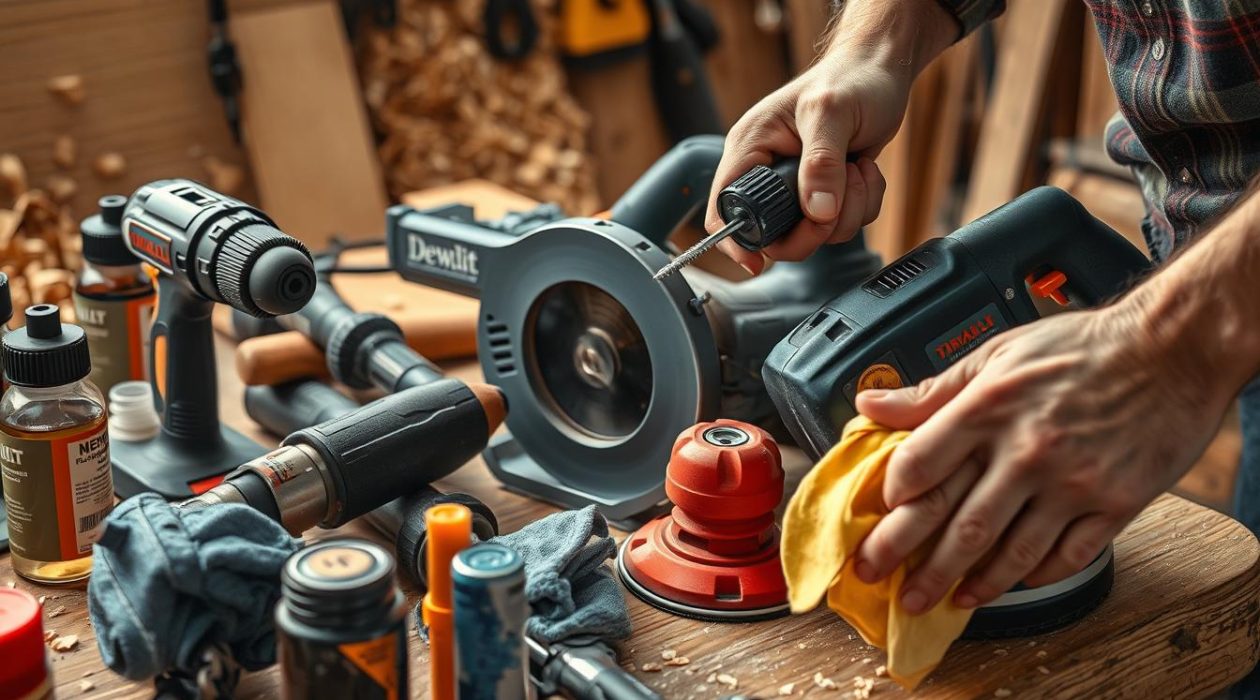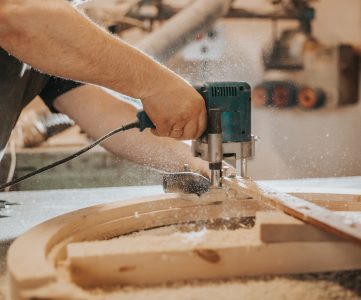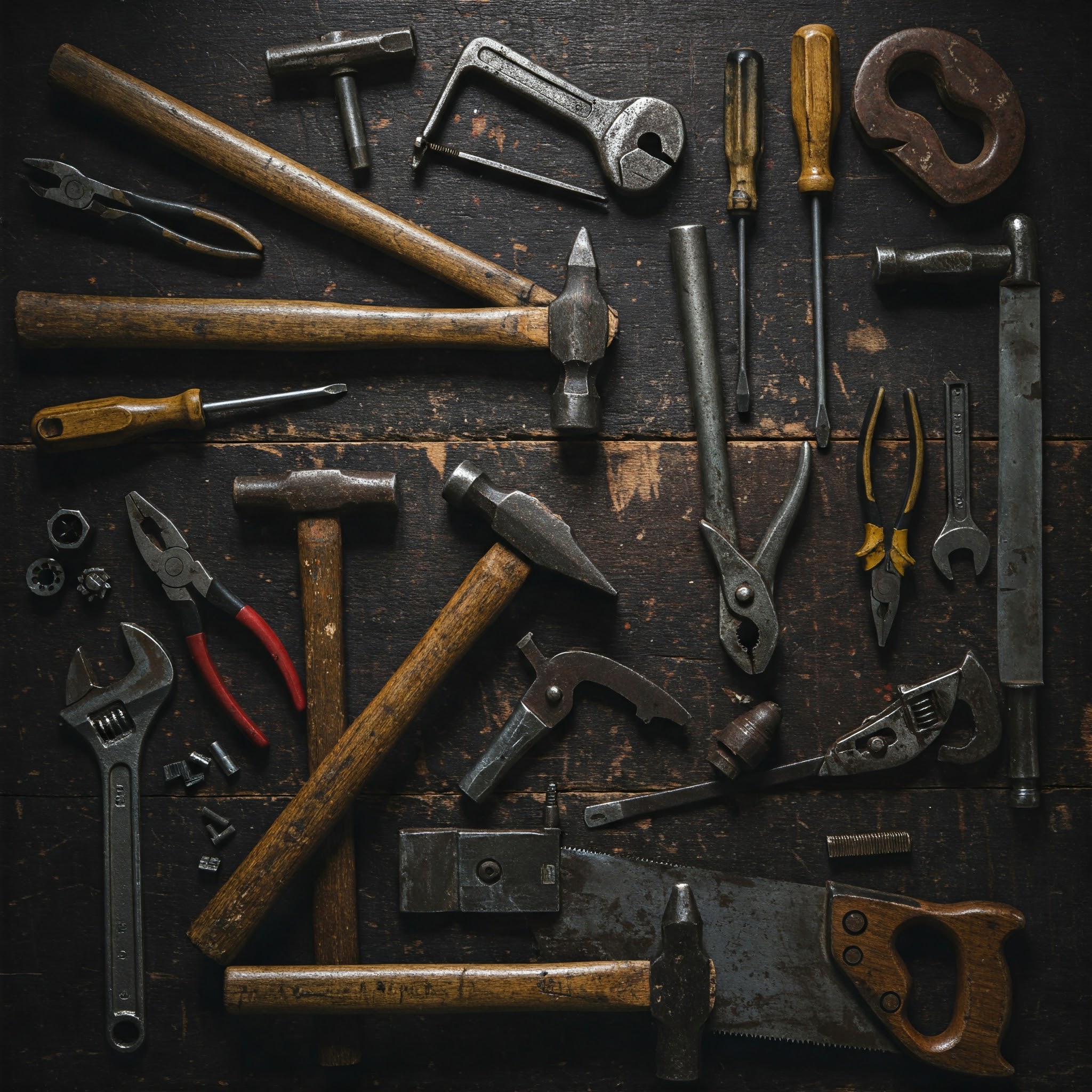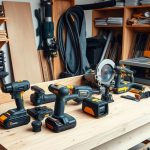Proper tool maintenance is key to ensuring power tools work efficiently and safely. By adopting the right maintenance practices, users can extend their tools’ lifespan and avoid costly repairs. Regular cleaning and maintenance prevent damage and reduce repair needs.
Power tool cleaning is vital for tool upkeep and should be done frequently. It’s not just about cleaning; inspecting and maintaining tools is also crucial. By focusing on cleaning and maintenance, users can ensure their tools perform well for a long time.
Investing time in cleaning and maintaining power tools offers several benefits. Regular upkeep helps spot issues early, reducing downtime and boosting productivity. With the right maintenance and cleaning schedule, tools stay in prime condition, ensuring long-term performance.
Introduction to Tool Maintenance
Tool maintenance is critical for the longevity and performance of power tools. A consistent cleaning and maintenance routine prevents damage and reduces repair needs. Effective maintenance combines regular cleaning, inspection, and upkeep to ensure tools function efficiently and safely.
Key Takeaways
- Regular power tool cleaning is essential for maintaining tool performance and longevity
- Tool maintenance involves more than just cleaning, it also includes inspecting and maintaining tools
- Effective tool maintenance can help prevent damage and reduce the need for costly repairs
- Power tool cleaning and tool maintenance can help identify potential issues before they become major problems
- Regular maintenance can help increase productivity and reduce downtime
- Investing time in power tool cleaning and tool maintenance can help extend the lifespan of tools
Understanding the Importance of Power Tool Maintenance
Regular maintenance is key to extending the life and performance of power tools. By adhering to a tool care guide, users can guarantee their tools work efficiently and safely. This involves cleaning, lubricating, and inspecting tools on a regular basis.
Regular maintenance offers several benefits:
- Extended tool lifespan
- Improved performance and efficiency
- Reduced risk of accidents and injuries
- Cost savings through reduced repair and replacement needs
Why Regular Maintenance Matters
Regular maintenance is vital for preventing tool damage and ensuring user safety. By incorporating maintenance tips into their routine, users can spot potential issues early on.
The Cost Benefits of Proper Tool Care
Proper tool care can lead to long-term cost savings. By following a tool care guide, users can reduce the need for repairs and replacements. This results in substantial cost savings.
Safety Aspects of Well-Maintained Tools
Well-maintained tools are safer to use, as they are less likely to malfunction or cause accidents. Regular maintenance tips help users identify and address potential safety hazards.
Essential Safety Precautions Before Starting Maintenance
When tackling power tool cleaning and maintenance, safety must be paramount. Before diving into maintenance, it’s vital to take the right safety precautions to sidestep potential dangers. This means donning protective gear like gloves, safety glasses, and a dust mask to shield against debris or chemicals.
Ensuring the tool is unplugged and disconnected from power sources is a critical safety step. This move prevents accidental start-ups and electrical shocks. It’s also crucial to be mindful of hazards like sharp edges, loose parts, or exposed wires.
Some key safety measures to remember for power tool cleaning and maintenance include:
- Always unplug the tool before starting maintenance
- Wear protective gear such as gloves, safety glasses, and a dust mask
- Be aware of potential hazards such as sharp edges, loose parts, or exposed wires
- Use proper cleaning techniques and materials to avoid damaging the tool
By adhering to these safety precautions, you can ensure a safe and effective maintenance process. Remember, safety should always be the utmost concern when handling power tools, whether in use or during maintenance.
Regular maintenance is also crucial for accident prevention and tool functionality. By dedicating time to regular power tool cleaning and maintenance, you can prolong your tool’s lifespan and avoid expensive repairs.
| Safety Precaution | Importance |
|---|---|
| Unplugging the tool | Prevents accidental start-ups or electrical shocks |
| Wearing protective gear | Prevents injury from debris or chemicals |
| Being aware of potential hazards | Prevents accidents and ensures a safe working environment |
Basic Tool Maintenance Schedule and Checklist
To keep your power tools in top shape, a regular maintenance schedule is crucial. It includes daily, weekly, and monthly tasks essential for tool care. By sticking to these routines, you can avoid damage, reduce wear, and extend your tools’ lifespan.
A well-thought-out maintenance plan is key for tool care. It prevents unexpected breakdowns and costly repairs. By sticking to a consistent schedule, you can spot issues early, saving time and money.
Daily Maintenance Tasks
Daily tasks are simple yet vital for maintaining your power tools. These include:
- Cleaning the tool after use to prevent dirt and debris buildup
- Checking for loose screws or damaged cords
- Storing tools in a dry, secure location to prevent damage
Weekly Cleaning Routine
A weekly cleaning routine is necessary to keep your tools in good working condition. This involves:
- Using a soft brush to remove dust and debris from the tool’s exterior
- Applying a lubricant to moving parts to reduce friction and wear
- Inspecting the tool’s cord and plug for signs of damage
Monthly Deep Clean Requirements
Monthly deep cleaning is necessary to remove stubborn dirt and grime that can affect your tool’s performance. This involves:
- Disassembling the tool to clean hard-to-reach areas
- Using a cleaning solution to remove stubborn stains and grime
- Inspecting the tool’s internal components for signs of wear or damage
By following this basic tool maintenance schedule and checklist, you’ll ensure your power tools stay in good working condition. Regular maintenance is essential for extending your tools’ lifespan and preventing costly repairs.
Proper Cleaning Techniques for Different Power Tools
Understanding the right cleaning methods for power tools is crucial. Power tool cleaning techniques vary significantly, and improper methods can harm your equipment. For example, drills and saws benefit from a soft brush to clear debris. On the other hand, sanders and routers need a more detailed cleaning with a vacuum and a damp cloth.
To keep your power tools in prime condition, it’s vital to adhere to the correct power tool cleaning techniques. Here are some essential tips to begin with:
- Use a soft brush to clean drills and saws
- Use a vacuum and a damp cloth to clean sanders and routers
- Avoid harsh chemicals or abrasive materials that can damage your tools
By employing these power tool cleaning techniques, you can prolong your tools’ lifespan and ensure they function at their best. Always consult your tool’s manual for specific cleaning guidelines, as each tool may have unique needs. With the appropriate cleaning methods and regular upkeep, your power tools will remain in excellent condition, delivering professional-grade outcomes.
| Power Tool | Cleaning Method |
|---|---|
| Drills | Soft brush and dry cloth |
| Saws | Soft brush and dry cloth |
| Sanders | Vacuum and damp cloth |
| Routers | Vacuum and damp cloth |
Advanced Tool Maintenance Procedures
For those aiming to elevate their power tool care, advanced maintenance is key. It encompasses a variety of steps beyond simple cleaning and maintenance. Mastering these methods can significantly prolong your tools’ lifespan and maintain their performance.
Advanced maintenance includes tasks like motor maintenance tips and tool maintenance tips for bearings and gears. It’s also vital to regularly inspect electrical parts to avoid damage and ensure safety. Key advanced maintenance tasks include:
- Checking and replacing worn or damaged bearings and gears
- Cleaning and lubricating motor components
- Inspecting electrical components for signs of wear or damage
Adopting these advanced maintenance steps can prevent issues like reduced power, increased vibration, and overheating. Regular maintenance also helps spot potential problems early, reducing repair costs and downtime.
Additional tool maintenance tips include storing tools in a dry, cool area, avoiding extreme temperatures, and using a soft cloth for cleaning. Combining these tips with regular advanced maintenance ensures your power tools remain in top condition for years.
Investing time and effort in advanced maintenance extends your power tools’ life, reduces repair needs, and maintains performance. Whether you’re a professional or a DIY enthusiast, advanced maintenance is crucial for maximizing your power tools’ potential.
| Task | Frequency | Importance |
|---|---|---|
| Motor maintenance | Monthly | High |
| Bearing and gear inspection | Every 3 months | Medium |
| Electrical component inspection | Every 6 months | High |
Essential Cleaning Supplies and Equipment
To ensure your power tools remain in peak condition, acquiring the correct cleaning supplies and maintenance equipment is paramount. This entails a range of items such as brushes, cloths, and specialized cleaning solutions. Possessing these fundamental tools is essential for efficient and safe maintenance of your power tools.
A comprehensive list of necessary cleaning supplies includes:
- Soft-bristled brushes for removing dirt and debris
- Lint-free cloths for wiping down tools
- Mild cleaning solutions for sanitizing and degreasing
- Storage containers for organizing and protecting your tools
Employing the appropriate maintenance equipment significantly enhances the lifespan and functionality of your power tools. By investing in these critical items, you ensure your tools operate optimally, thus minimizing the likelihood of expensive repairs and replacements.
Renowned brands such as 3M, DeWalt, and Milwaukee offer a variety of high-quality cleaning supplies and maintenance equipment. These brands provide products designed to facilitate effortless maintenance of your power tools.
Equipping yourself with the right cleaning supplies and maintenance equipment ensures your power tools function efficiently and reliably. This approach not only conserves time and resources but also guarantees your safety when operating power tools.
| Cleaning Supply | Description |
|---|---|
| Brushes | For removing dirt and debris |
| Cloths | For wiping down tools |
| Cleaning Solutions | For sanitizing and degreasing |
Storage Solutions for Optimal Tool Protection
Proper storage is key to maintaining power tools. It’s crucial to consider the environment and use the right storage solutions to prevent damage and theft. Effective tool storage ensures tools stay functional and efficient.
A well-organized storage space is essential for protection solutions. Extreme temperatures and humidity can damage tools. Storing tools in a controlled environment prevents rust, corrosion, and other damage.
Climate Control Considerations
Climate control is vital for storing power tools. Tools should be kept in a dry, cool place, away from sunlight and moisture. This prevents damage and extends tool lifespan.
Organizing Your Tool Storage Space
A well-organized storage space boosts productivity by allowing quick tool access. Use toolboxes, cabinets, and pegboards for organization. Label and categorize tools for easy access and proper storage.
Effective tool storage and protection solutions keep power tools in top condition. This reduces the need for repairs and replacements. It saves time and money, boosting productivity and efficiency.
Troubleshooting Common Maintenance Issues
Mastering troubleshooting is crucial in power tool maintenance. Even with diligent care, maintenance issues can still occur, leading to frustration and lost time. We’ve compiled practical advice to help you identify and resolve common problems.
Common maintenance issues include faulty motors, damaged batteries, and worn-out parts. Begin by examining the tool’s power source, cables, and connections. Ensure all parts are securely attached and working as they should. If the problem continues, refer to your tool’s manual or reach out to the manufacturer’s support.
Here are some additional tips for troubleshooting common maintenance issues:
- Regularly inspect your tools for signs of wear and tear
- Keep your tools clean and well-maintained to prevent damage
- Use genuine replacement parts to ensure compatibility and quality
By adhering to these tips and being proactive, you can reduce downtime and swiftly return to work. Always prioritize safety and follow best practices when troubleshooting and maintaining your power tools.
Professional Tool Maintenance Services vs DIY Care
Users often debate whether to choose professional maintenance or DIY care for power tools. Each method has its advantages and disadvantages. Professional maintenance brings expertise and specialized tools, while DIY care offers cost savings and flexibility.
For intricate problems or high-end tools, professional maintenance is usually the better option. It guarantees the work is done right and safely, reducing the chance of damage or injury. In contrast, DIY care is ideal for simple tasks like cleaning and lubricating tools.
When to Call a Professional
- Complex tool repairs or overhauls
- High-value or specialized tools
- Electrical or mechanical issues
Cost Comparison Analysis
| Maintenance Type | Cost | Benefits |
|---|---|---|
| Professional Maintenance | $50-$200 | Expertise, specialized equipment, warranty |
| DIY Care | $10-$50 | Cost savings, flexibility, convenience |
Extending Your Power Tools’ Lifespan Through Proper Use
Using power tools correctly is key to extending their tool lifespan. Adhering to best practices ensures your tools last longer and work better. A critical part of proper use is preventing overheating. This can harm the motor and other parts.
Here are some tips to extend your power tools’ lifespan:
- Use the correct accessories and attachments for each tool
- Avoid overloading the tool, as this can cause excessive wear and tear
- Keep the tool clean and well-maintained, including regular lubrication of moving parts
- Store the tool in a dry, cool place, away from direct sunlight
By adhering to these guidelines, you can greatly extend the tool lifespan. This ensures your power tools continue to function at their best. Remember, proper use is vital for maximizing your tools’ performance and protecting your investment.
Regular maintenance and inspections also play a crucial role. They help spot issues early, preventing major problems. Combining proper use with regular upkeep maximizes the tool lifespan. This way, you get the most out of your power tools.
Preventive Maintenance Tips and Best Practices
Regular preventive maintenance is key to extending power tool lifespan and ensuring peak performance. Adopting best practices helps avoid unexpected tool failures and cuts down on maintenance costs. A seasonal maintenance schedule is an effective approach to achieve this.
Seasonal Maintenance Guidelines
Seasonal changes significantly impact power tool performance and longevity. Extreme temperatures and humidity can harm tool motors and batteries. To counter this, users should adhere to a seasonal maintenance plan that includes:
- Winter: Store tools in a dry, cool place to prevent rust and corrosion
- Summer: Check tool batteries and motors for signs of overheating
- Spring and Fall: Inspect tools for damage and perform routine cleaning and lubrication
Documentation and Tracking Methods
It’s vital to keep maintenance records up to date to ensure tools are always ready for use. Users can use various documentation methods such as:
- Maintenance logs to record cleaning, inspection, and repair activities
- Tool inventory management systems to track tool usage and location
By adhering to these preventive maintenance tips and best practices, users can maintain their power tools in optimal condition. This reduces the need for expensive repairs and replacements.
Maintaining Your Investment in Quality Tools
Maintaining your power tools is crucial for their long-lasting performance. By following the guidelines and tips in this article, you can ensure your tools operate at their best. This provides years of reliable service. Each step, from basic cleaning to advanced maintenance, is vital in preserving your tools’ quality and functionality.
Regular tool maintenance prevents problems before they occur. It ensures your tools remain safe to use and protects your investment in quality equipment. By dedicating a small amount of time and effort to proper care, you can extend your power tools’ lifespan. This way, you’ll enjoy their optimal performance for years.
Well-maintained power tools operate more efficiently and contribute to your safety. They also extend the life of your investment. Embrace the maintenance guidelines to transform your power tools into reliable, long-lasting companions in your workshops, jobsites, and DIY projects.






